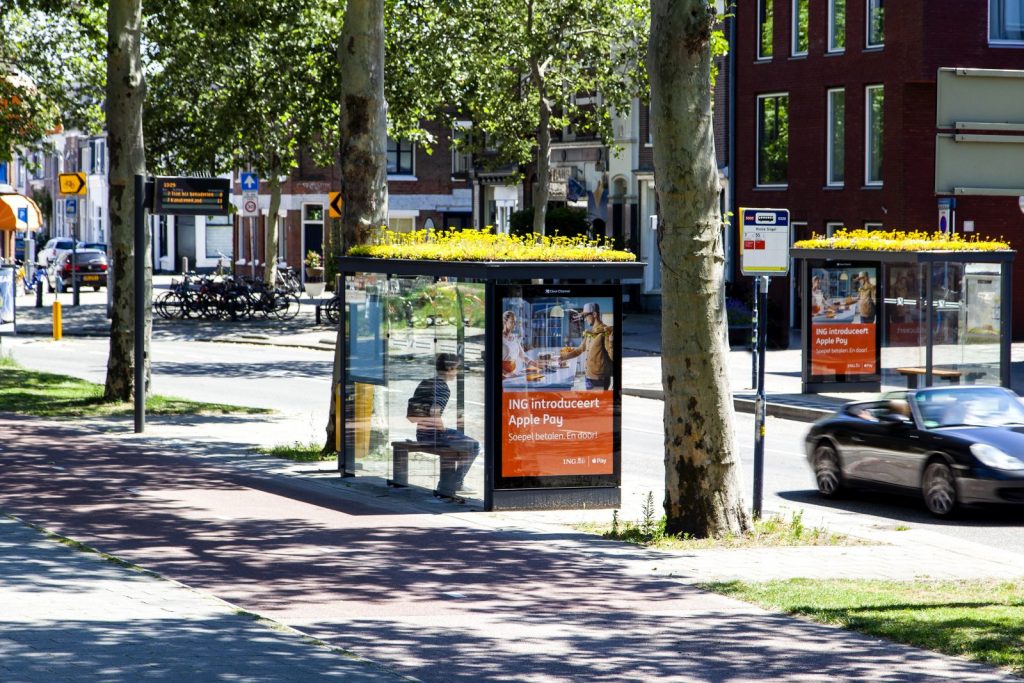The Buses That Make a Bee Line
Bees — the buzzy, honey-making creatures with stingers that most children fear — have been a focal point for many ecologists over the past few years. As the USDA notes, “beginning in 2006, experts noted significant yearly declines in honey bee colonies,” and that’s a bad thing, regardless of your opinion on honey or bee stings. Bees and other pollinators are a vital part of “producing marketable commodities” per the USDA, which is to say that a lot of stuff doesn’t get made if bees go away.
Keeping bee populations thriving is tricky, though; it’s not exactly clear what is causing declines (colony collapse is a leading theory) and therefore, it’s we’re not sure how to fix it. But one thing is likely true: there’s no downside, bee stings aside, from having more places for bees to hang out.
Which is why, if you’re a commuter in the Dutch city of Utrecht, they may be buzzing over your heads. Here’s a picture (via This Is Colossal):

See the bees there? No? Okay, they’re too small — and too few and far between, as of the taking of that picture — to be seen. But if you look on the top of the bus shelters, you’ll see the idea in motion. There are little gardens growing on the shelter roofs.
Across the city there are 316 of these gardens. Each bus shelter is topped with sedum, a “hardy, easy to care for” type of flower according to The Old Farmer’s Almanac, and importantly, one that is “beloved by pollinators.” The plants take very little in the way of care — the Almanac notes that “as long as your area gets rain every couple of weeks at the least, sedum shouldn’t need any extra watering,” and Utrecht definitely gets enough. Once the little garden is planted and begins to thrive, it basically manages itself. And according to the city’s website, the idea “costs the municipality nothing: the bus-shelter operator pays for the installation and maintenance with income from advertising.”
And while it may not seem like a great idea to have bees buzzing over your head, the people of Utrecht don’t seem to mind. In an interview with PRI, a city project manager named Maurice Prijs said that the reaction from bus riders has been “very, very, very positive. Everybody really likes it because of the decrease in bee population everybody feels responsible for it. And on the other hand, people say it also looks very nice. It’s more exciting to wait on the bus and stands on a green roof and enjoy a bit of biodiversity because of that.” (Besides, honeybees tend not to sting unless they’re threatened, so as long as you don’t climb on the bus shelter’s roof, you’re probably okay.)
But more importantly, these “bee stops” — and other innovations (see the bonus fact below!) — may bee, er, may be working. Each year, volunteers across the Netherlands take to streets and fields alike to count the bees, trying to get a somewhat accurate estimate of the nation’s bee population. According to the Guardian, the 2021 census showed that the “bee population [was] steady in Dutch cities,” an improvement after years of decline.
Bonus fact: Another way Utrecht is helping revive the bee population: bee hotels. Sometimes, solitary bees leave their hives, never to return. That leaves them without a place to make their nests, so many bee aficionados build these little “hotels” for them to lay their eggs in. (They cost about $20 or you can build your own, if you’re so inclined.) In the summer of 2020, Utrecht took that idea and supersized it. As Life & Soul Magazine reported, the city wrapped a 28 meter-high (92 feet) billboard with “over 200 nesting boxes for wild bees and butterflies,” and also created a place for them to feed. The magazine continues: “wild bees look for pollen and nectar within 200 meters (650 feet) of their nesting site, and so the area was planted with a 7,000 m2 (1.7 acres) field of wildflowers, as well as sand and hills for bees that nest in the ground.” You can see the bee hotel-wrapped billboard here.
From the Archives: Red Honey: A story about urban bees.
